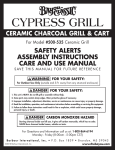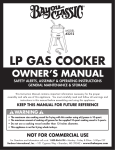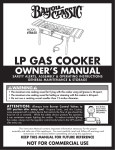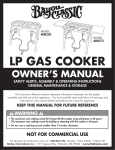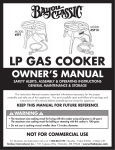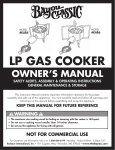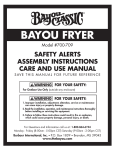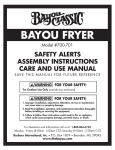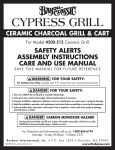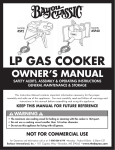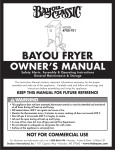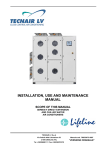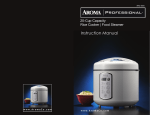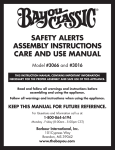Download Bayou Classic SP1 Owner`s manual
Transcript
MODELS
#2625
#3025
#1118
TURKEY FRYING STOCKPOT
OWNER’S MANUAL
SAFETY ALERTS, ASSEMBLY & OPERATING INSTRUCTIONS
GENERAL MAINTENANCE & STORAGE
This Instruction Manual contains important information necessary for the
proper and safe use of this stockpot. You must carefully read and follow all warnings
and instructions in this manual before using this stockpot.
KEEP THIS MANUAL FOR FUTURE REFERENCE
WARNING
• The maximum size turkey for frying in this stockpot is 18-lb.
NOT FOR COMMERCIAL USE
For Questions and Information call us at: 1-800-864-6194
Barbour International, Inc.
•
101 Cypress Way
•
•
Monday - Friday 8:00am - 5:00pm CST
Brandon, MS 39042
•
www.thebayou.com
CONTENTS
Warnings & Dangers
Cooking with Oil or Grease
General Warnings for Gas Cookers
Placement and Positioning of your Cooker
Gas Leak Testing
Testing & Placement of the Thermometer
1-2
3
4-5
5
6-7
8
Operating Instructions
Oil & Grease Level Determination
Preparation & Frying Instructions
Cooking with Oil: Important Facts to Know
Frequently Asked Questions about Frying
Care and Use Instructions
9
9
10 - 12
12 - 13
14 - 16
16
If you have a missing or damaged part, please do not return
this item to the store.
Call Barbour International, Inc. for assistance:
1-800-864-6194
Monday-Friday 8:00am - 5:00pm CST
SAFETY SYMBOLS
The symbols and boxes shown below explain what each heading means. Read and follow all of the safety
warnings and instructions contained in this manual and on the cooker.
THE PURPOSE OF THIS SAFETY ALERT SYMBOL
IS TO ATTRACT YOUR ATTENTION TO POSSIBLE
HAZARDS AS YOU ASSEMBLE AND USE THIS PRODUCT.
WHEN YOU SEE THE SAFETY ALERT SYMBOL
PAY CLOSE ATTENTION TO THE INFORMATION WHICH FOLLOWS!
Indicates an imminently hazardous situation which,
if not avoided, will result in death or serious injury.
Hazard or unsafe practices which could result in
severe property damages, personal injury, or death.
Hazard or unsafe practices which could result in
minor personal injury, product, or property damages.
Carefully read and follow all WARNINGS, SAFETY PRECAUTIONS and OPERATING INSTRUCTIONS
contained in this manual and on the cooker.
DO NOT skip any of the warnings and instructions! SAVE THIS MANUAL FOR FUTURE REFERENCE.
DANGER
IF OIL OR GREASE FIRE OCCURS
In the event of an oil/grease fire, do not attempt to extinguish with water. Immediately call your local
Fire Department. A Type BC or ABC dry chemical fire extinguisher may in some cases contain the fire.
If a fire occurs INSIDE THE COOKING VESSEL follow these steps.
• Turn off gas supply.
• Wearing a protective glove, cover the pot with a lid. DO NOT re-open lid as the oil/grease fire could
re-ignite. Allow cooking vessel to cool down to 115˚F (45˚C) before opening lid.
If a fire occurs OUTSIDE THE COOKING VESSEL follow these steps.
• Turn off the gas supply if possible.
• Wearing a protective glove, cover the pot with a lid if possible.
• Call the local Fire Department if property damage is possible.
• Attempt to extinguish using a chemical fire extinguisher specified.
• Once fire is extinguished, DO NOT re-open lid as the oil/grease fire could re-ignite. Allow cooking
vessel to cool down to 115˚F (45˚C) before opening lid.
WARNING
A. DO NOT store a spare LP cylinder under or near a gas cooker appliance.
B. Never fill the cylinder beyond 80% full.
C. If the information in (A) and (B) are not followed exactly, a fire causing death
or serious injury may occur.
IMPORTANT NOTE TO CONSUMER
In addition to regular cooking, this stockpot can be used for frying whole turkeys or chickens on outdoor
gas cookers. It can be used on most brands of outdoor gas cookers which have far greater heat output
than traditional kitchen stoves. Same as kitchen stoves, outdoor gas cookers do not have automatic
thermostat controls so must be attended and monitored at all times during use. Never attempt frying
whole turkeys or chickens on indoor kitchen stoves.
Carefully read, understand and follow these instructions and warnings along with those on your cooker.
If you no longer have your cooker instruction manual, in most cases one can be downloaded from the
brand’s website. If you do not have or cannot obtain your cooker instruction manual, this manual does
contain generic gas cooker instructions and warnings. If you are unsure or have doubts about how to
properly ignite and operate your gas cooker, then do not attempt any form of outdoor cooking or frying!
This stockpot can be used for frying whole turkeys/chickens on Bayou Classic® cooker models SP10,
SQ14, 1114, SP1 having gas pressure ratings of 10 psi and cooker height below 14" tall. Do not use
this stockpot to fry whole turkeys/chickens on Bayou Classic® cooker models KAB4, KAB6, SP2, SP40,
SP50, B135, B159, 2212 as they either have pressure ratings above 10psi or have a height above 14"
tall. Bayou Classic® cooker Instruction Manuals can be downloaded at www.thebayou.com.
WARNING
Do not fry turkeys larger than 18-lb in this stockpot. Turkeys above 18-lb can increase the chance
of an oil spill over and fire which can cause severe burns and/or property damage.
This stockpot is designed tall and narrow so that it can be used for frying whole turkeys while minimizing
the use of cooking oil. However, safely inserting and removing a whole turkey from a tall stockpot requires
a low profile cooker frame.
WARNING
Do not fry whole turkeys on cookers taller than 14" (inches) high. Use of a tall stockpot on a tall
cooker frame increases the risk of tipping and spillage of hot cooking oil when inserting or removing
a turkey, which could result in a flash fire and severe burns.
This stockpot can be used for frying whole turkeys on high pressure gas cookers having a pressure output
ranging from 5 psi to 10 psi (Pounds per square inch).
WARNING
• Do not fry whole turkeys on outdoor gas cookers having a pressure rating above 10psi.
Frying with this stockpot on gas cookers having a pressure rating above 10psi can accelerate the
possibility of overheating cooking oil to the point of spontaneous combustion and fire.
1
SAFETY PRECAUTIONS AND WARNINGS
WARNING
Outdoor Gas Cookers do not have automatic thermostat controls.
Failure to follow these instructions could result in fire or explosion
which could cause property damage, personal injury or death!
ALWAYS
operate in a open area
a minimum of 10-ft from
buildings, trees
and overhangs.
NEVER
use on decks, boats or
any combustible surface!
NEVER!
No barefeet or sandals
when cooking.
OUTDOOR USE ONLY!
NEVER
LEAVE COOKER
UNATTENDED!
Do not operate inside
garages, carports
or patios.
NEVER
NEVER
place flammable or
combustible materials
within 25-ft of cooker.
cover pot with lid when
preheating oil or frying.
HOT!
ALWAYS
Extremely hot during and after use. wear protective mitts, gloves,
goggles and long sleeve
Allow appliance to cool
clothing when cooking.
below 115˚F (45˚C)
before cleaning or storing
NEVER
use under any
roof or overhang.
NEVER!
allow children or pets near
the cooking area
during and after use.
ALWAYS
use an accurate thermometer
to monitor temperature when
preheating oil or frying.
Remember: Think Safety and Use Common Sense!
2
WARNING
COOKING WITH OIL OR GREASE
• Outdoor gas cooker appliances do not have automatic thermostat controls so must be attended and
monitored at all times during oil heat up and frying.
• The maximum size turkey for frying in this stockpot is 18-lbs.
• The maximum amount of oil for frying in this stockpot is 3.5 gallons.
• When cooking with oil/grease, the thermometer provided must be used. Follow instructions in this
manual for proper testing, installation and use of the frying thermometer.
• Follow instructions contained in this manual for proper positioning of a cooker and
gas leak test, determining proper amount of oil to use, heat-up and frying
operation, cleanup and storage.
• Cooking oil pre-heat up to over-heat times can vary significantly with relatively small adjustments
to regulator; variable wind, ambient temperature, altitude, starting oil temperature, and type of
cooking oil used.
• Due to varying heating and cooking times, check the provided thermometer every 3 minutes to ensure
cooking oil does not exceed 400˚F (200˚C). Gas cookers are an ATTENDED appliance. DO NOT
leave appliance unattended while heating oil/grease, cooking food or cool down period after use.
• Do not allow cooking oil/grease to exceed 400˚F (200˚C) which is the FIRE HAZARD zone on the
thermometer. Cooking oil/grease will ignite and catch fire at 550˚F to 700˚F (287˚C to 371˚C).
• DO NOT use a lid when pre-heating or cooking with oil. Using a lid when frying greatly
increases the potential of over-heating the oil to ignition and fire.
• Smoking oil is an indication that the oil is too hot and may ignite. Regardless of thermometer
reading, if the oil/grease starts to smoke, turn OFF fuel supply to the burner and
STOP COOKING IMMEDIATELY. This indicates the thermometer is not working properly.
Discard the thermometer and call 1-800-864-6194 M-F 8am - 5pm CST for assistance.
Replacement thermometer Model #5025.
• Never overfill the cooking vessel with oil/grease or water. Follow instructions in this manual for
establishing proper liquid levels for cooking.
• When frying with oil or grease, all food products MUST be completely thawed and towel dried
to remove excess water. Failure to completely thaw and dry foods may cause oil or grease to
overflow from cooking vessel. If ice is present on the food, it means the thawing process is not
complete and may cause a boil over when placed into HOT oil causing a fire and severe burns.
• Never drop food or accessories into hot liquids. Wear protective gloves and S-L-O-W-L-Y lower
food and accessories into cooking oil in order to prevent splashing or overflow. Be careful when
removing food from oil. It is hot and could cause burns.
• In the event of rain, snow, hail, sleet or other form of precipitation while cooking with oil,
cover the cooking vessel and immediately turn off the burner and gas supply. DO NOT MOVE
cooker or cooking vessel.
• When cooking with oil/grease, have a BC or ABC type fire extinguisher readily accessible.
• Never attempt frying whole turkeys or chickens on indoor kitchen stoves.
• The cooking vessel remains at scalding temperatures long after cooking has ended. Allow appliance
to cool below 115˚F (45˚C) before cleaning or storing. Cool down period varies with amount of
oil/grease used, wind and ambient temperature.
3
WARNING
GENERAL OPERATING WARNINGS for Outdoor Gas Cookers
• Outdoor Gas Cookers do not have automatic thermostat controls so must be attended and monitored
at all times during use.
• Gas Cookers have an open flame. In sunlight or other bright light, the flame may be almost invisible.
Use extreme caution keeping hands, hair and clothing away from the cooker. Do not lean over the
cooker when lighting burner. Loose hair and clothing can catch fire during lighting and operation.
• Gas Cookers are an ATTENDED appliance, DO NOT leave gas appliances unattended while
heating oil, grease or water, cooking food or when hot after use (oil, grease or water above
115˚F: 45˚C). Heated liquid can remain at scalding temperatures long after cooking has ended.
• When cooking with oil/grease, the provided thermometer must be used to monitor temperature.
Check the thermometer every 3 minutes to ensure cooking oil does not exceed 400˚F (200˚C)
which is the fire hazard zone on the thermometer. Oil/grease heated above 400˚F (200˚C) will
ignite and catch fire causing property damage, personal injury or death.
• Even when burner is set at a low flame, never leave a gas cooker unattended. Cooking oil/grease
will heat up quickly and ignite at 550˚F to 700˚F (287˚C to 371˚C).
• Keep children and pets away from the cooking area at all times. Carefully monitor all activity
around cooker to avoid burns or other injuries.
• Gas cookers and stockpots will be extremely hot during and after use. Use insulated oven mitts
or gloves for protection from hot surfaces or splatter from cooking liquids. Always wear closed toe
shoes while cooking with any gas appliance.
• Use caution when walking or standing near cooker as splattered oil may have created a slick
surface. Do not walk between cooker and propane tank as this creates a trip hazard.
Tripping over the hose could overturn the cooker.
• Avoid bumping of or impact with the appliance to prevent spillage or splashing of hot cooking
liquid which can cause sever burns.
• DO NOT move the cooker and stockpot when in use. Allow cooking vessel to cool down to
115˚F (45˚C) before moving, cleaning or storing.
• Should the burner flame go out during use, turn all gas valves off. Wait 5 minutes for gas to evacuate
before re-lighting. Follow your cooker’s Instruction Manual for lighting and re-lighting your gas cooker.
• Never overfill a cooking vessel with oil, grease or water. Overfilled cooking vessels can boil
over and cause a fire. Follow instructions in this manual for establishing proper liquid level.
• After a period of storage or nonuse, check the cooker for gas leaks before use. See instructions
in this manual for correct procedures.
• DO NOT place an empty cooking vessel on a gas cooker while in operation as it could melt.
Use caution when placing anything in a cooking vessel while the cooker is in operation.
• Children can fall a into cooking vessel and drown in even a small amount of liquid. Keep cooking
vessel out of reach of children. Do not store your cooking vessel with liquid inside.
• When cooking with oil/grease, have a Type BC or ABC fire extinguisher readily accessible.
• Combustion by-products from the use of gas cookers contain chemicals known to the
State of California to cause cancer, birth defects, or other reproductive harm.
4
WARNING
PLACEMENT OF GAS COOKER APPLIANCES
• Gas cookers shall be used OUTDOORS ONLY. DO NOT use in a building, home, garage, balcony,
porch, tent or any other enclosed area. Gas cookers shall not be used on or under apartment,
condominium balcony or deck.
• DO NOT operate a Gas Cooker closer than 10 feet (3m) from any combustible materials
including walls or railing, or under overhead construction and tree branches as these materials
could ignite should oil/grease fire occur.
• The cooker must be positioned on a level, stable, noncombustible surface such as brick, concrete
or dirt. Do not position cooker on wood, asphalt or plastic which may burn, blister or melt.
• Do not use on combustible flooring or surfaces such as wooden decks.
• Do not store or use gasoline or other liquid/aerosols with flammable vapors within 25 feet (7.5m)
of gas cooker. Keep the cooking area clear and free of any combustible material such as household
chemicals, paint, gasoline and other flammable vapors and liquids.
• Prior to lighting the burner, check wind direction for placement of cooker DOWNWIND from
upright LP cylinder. The cooker must be DOWNWIND and least 20" away from LP cylinder to
keep heat away from cylinder.
POSITIONING YOUR COOKER
1. Check wind direction.
2. Position cooker DOWNWIND from the nearest structure; no closer than 10-ft from nearest building
or railing, keeping flames from any potential oil/grease fire away from nearest structure.
3. Position cooker DOWNWIND from the LP Gas Cylinder keeping a minimum distance of 20" apart
so the heat of the cooker does not reach cylinder.
4. Position cooker on level ground in a well ventilated location, a safe distance from combustible
materials, rails, buildings, overhangs or tree branches.
Make sure overhead is clear of combustible materials!
Wind Direction
10 ft.
Clearance
20 in.
Minimum
10 ft.
Clearance
Hose is a trip hazard. Do not walk between cooker and cylinder.
5
GAS LEAK TESTING for all brands of Gas Cookers
DANGER
LEAK TESTING
To prevent fire or explosion hazard:
•
•
•
•
DO NOT smoke or permit ignition sources in the area while conducting a leak test.
Perform test OUTDOORS only in a well ventilated area at least 10-ft. away from any structure or trees.
Never perform a leak test with a match or open flame.
Never perform a leak test while the cooker is in use or while cooker is still hot.
WARNING
WHEN TO PERFORM A LEAK TEST
•
•
•
•
After assembling your cooker and before lighting for the first time, even if purchased fully assembled.
Every time the LP gas cylinder is refilled or if any of the gas components are replaced.
Any time your cooker has been moved.
At least once per year or if your cooker has not been used for more than 60 days.
6
GAS LEAK TEST INSTRUCTIONS
Note: The gas leak test must be performed in an area that has
adequate lighting in order to see if bubbles are developing.
DO NOT use a flashlight to check for bubbbles.
1. Create a mixture of 50% water and
50% liquid dishwashing soap.
2. Turn the gas cylinder valve to the OFF position (clockwise).
Then turn regulator valve to OFF position.
3. To turn ON the fuel supply, turn the cylinder valve
knob one turn counter-clockwise. Gas will flow through
and stop at the closed regulator valve.
4. Using a clean brush, apply the soap water mixture
to the following:
Cylinder Valve to Cylinder
Connection Nut to Cylinder Valve
Back side of Connection Nut to Brass Nipple
Brass Valve next to Regulator, or on Regulator
Regulator connection to Gas Supply Hose
LP Cylinder Welds
Full length of Gas Supply Hose
Gas Supply Hose connection to Burner
5. Check each place A - F for growing bubbles
which indicates a leak.
6. Next, turn ON regulator valve to permit gas to pass through
the hose. Apply soap water mixture to full length of
gas supply hose and connection to burner assembly.
Check each place for growing bubbles, G & H,
which indicates a leak.
7. Turn OFF gas supply valve (clockwise) on LP Gas Cylinder.
8. Turn regulator valve to OFF position.
9. Tighten any leaking connections.
10. Repeat soap water mixture test until no leaks are detected.
DO NOT use cooker if gas leaks cannot be stopped.
For assistance contact a qualified appliance repair service.
Watch for Bubbles
GAS SUPPLY HOSE
Burner
Jet Cooker
Orifice Bar
11. After you are certain there are no leaks, turn tank valve and
regulator valve to OFF position.
Wait 5 minutes for any gas fumes to evacuate before lighting the burner.
WARNING
If growing soap bubbles persist throughout any portion of the Gas Leak Test, terminate use immediately.
For assistance, contact your propane dealer or the supplier of your cooker.
7
THERMOMETER TEST INSTRUCTIONS
WARNING
Always use a thermometer when frying any food products. A thermometer is a sensitive measuring
device which may not work properly if dropped, bent, or twisted. Always check to be sure the
thermometer provided with this stockpot is working properly before frying.
2-STEP METHOD for Thermometer Testing
1. TEMPERATURE ACCURACY:
While wearing protective gloves, hold the thermometer by the dial and insert stem into boiling water.
The needle should quickly move around the dial and register approximately 212˚F (100˚C)
(plus or minus 5˚F). This indicates whether or not temperature reading is accurate. NOTE: Due to
water evaporation, the maximum reading possible on a thermometer in hot water is 212˚F (100˚C).
2. TEMPERATURE RANGE:
Hold thermometer by the dial and place end of the stem above a lit match or lighter. The needle
should quickly move around the dial and register a temperature reading far above 350˚F. If the needle
stops at a low temperature reading such as 225˚F; then the thermometer is damaged and cannot be
used. Discard the thermometer and call 1-800-864-6194 M-F 8am - 5pm CST for assistance.
Replacement thermometer Model #5025.
DO NOT attempt frying if the thermometer is not working!
FAILURE TO FOLLOW THESE INSTRUCTIONS COULD CAUSE A GREASE FIRE/EXPLOSION RESULTING IN
PERSONAL INJURY, PROPERTY DAMAGE OR DEATH.
WARNING
• The face of the thermometer becomes very hot during use. Wear protective gloves or mitts when handling.
• Sweat or condensation from cold beverages, if allowed to drip on the glass cover, could cause it to break.
• Tip of the thermometer probe can be a puncture hazard, use caution when handling. Keep point
away from eyes, face and hands.
• Always monitor thermometer temperature every 3 minutes during preheating and frying. After
reaching 400˚F, the temperature of the oil/grease can rapidly increase resulting in spontaneous
combustion and fire.
• Regardless of thermometer reading, if the oil/grease starts to smoke, turn OFF fuel supply to the
burner and STOP COOKING IMMEDIATELY. This indicates the thermometer is not working properly.
Discard the thermometer and call 1-800-864-6194 M-F 8am - 5pm CST for assistance.
Replacement thermometer Model #5025
PLACEMENT OF THERMOMETER
1. Make sure clip on thermometer is at the top of the probe (stem).
2. Attach the thermometer clip on the inside of the pot with the probe
immersed in the oil at least one inch.
Do NOT insert the probe into poultry. This is not a meat thermometer.
This can cause incorrect thermometer reading.
3. Check temperature reading every 3 minutes during heat-up
and when frying. Do NOT allow oil temperature to exceed 400°F.
Remember: Think Safety & Use Common Sense!
8
OPERATING INSTRUCTIONS
WARNING
Read, understand and follow all warnings and instructions contained in this manual.
• Follow instructions to determine proper liquid level for cooking.
• Make sure cooker is positioned at least 10-ft from all combustible materials including building
overhangs and tree branches.
• Check your cooker appliance for gas leaks.
• Test cooking thermometer to ensure accurate temperature reading.
• Do not exceed 3.5 gallons of cooking oil inside the stockpot.
• Follow Lighting and Re-lighting Instructions on your gas cooker appliance.
• Never leave oil unattended during preheating or cooking process as it can ignite and cause a fire.
Hot cooking oil is extremely hazardous and must be monitored at all times.
• Remain attended to your cooker and check the thermometer every 3 minutes during heat-up and
frying.
• Use extreme care when lowering food into and removing from hot oil or liquid.
• When cooking is completed, turn off gas to your cooker using the valve on propane tank.
OIL/GREASE LEVEL DETERMINATION for frying Whole Turkeys/Chickens
Follow the 6 steps below to determine the proper amount of oil to use in cooking vessels that do not have
maximum fill lines.
1. Place the raw poultry upside down on poultry rack.
2. Place the poultry and poultry rack into the empty vessel.
3. Add water into the vessel until the food product is almost submerged. There must be a minimum
of 3 inches between the water level and top of the vessel.
4. Remove the poultry from the vessel and either mark the level on the side of the vessel or measure
the depth of water in the vessel. This water level indicates the amount of cooking oil needed to cook
the food product.
NOTE: Cooking oil/grease will expand when heated and increases the level inside the cooking vessel.
As turkey size increases, the required amount of oil decreases.
5. Remove the water and completely dry the vessel and the food product.
6. Add cooking oil into the vessel up to the indicated level. The desired amount of cooking oil for frying
turkeys typically ranges from 3 to 3.5 gallons. The maximum amount of cooking oil to use in this
vessel in 3.5 gallons.
DANGER
IF THE INFORMATION IN ITEMS 1- 6 ABOVE IS NOT FOLLOWED EXACTLY, OIL OVERFLOW MAY
OCCUR CAUSING PROPERTY DAMAGE, PERSONAL INJURY, OR DEATH.
9
PREPARATION & FRYING for Whole Turkeys/Chickens
Instructions for safely performing cooking operations, as applicable to an outdoor gas cooker.
WARNING
• The maximum size turkey for this vessel is 18-lbs.
• Allow poultry to thaw completely... Very Important!
• Never, never insert frozen or partially frozen poultry into hot oil! Doing so will cause a violent
boil over and grease fire!
• Always test the thermometer to insure it is working properly!
• Never cover cooking vessel with lid during oil heat up or frying.
PREPARATION INSTRUCTIONS
1. Clean and dry poultry inside and out, removing giblets and neck, and trimming away all excess fat
and skin. Make sure opening around the neck cavity is wide and clear. . .very important!
2. Make a 1-inch cut in the skin at the leg-thigh joints. This allows oil to drain when poultry is done...
very important!
3. Rub poultry with seasonings. (use poultry seasoning, cajun seasonings or salt & pepper)
Optional: If using a liquid marinade, inject into poultry at various points on the breast, thighs, and
drumstick. (Figure #1 & 2)
Hint: When using a dry powder marinade, mix with Orange Juice instead of water. Acidity in the
Orange Juice enhances the marinade plus acts as a meat tenderizer.
4. Push plunger down slowly while pulling injector out of meat to give even distribution of seasoning.
Liquid marinades
Inject marinades
are available at
at various points
most Grocery
as shown.
Stores.
Figure #1
Figure #2
5. Place turkey upside down on rack, with legs facing up, no batter required.
Remember, poultry legs facing up. (Figure #5)
FRYING INSTRUCTIONS
WARNING
Gas cooker appliances do not have automatic thermostat controls so must be attended and monitored at all times
during use. When cooking with oil/grease, a thermometer must be used to monitor temperature. Oil/grease
heated above 400˚F (200˚C) will ignite and catch fire causing property damage, personal injury or death.
NOTE: Optimum frying temperature range is 325˚F to 350˚F (163˚C to 177˚C).
1. Follow instructions to properly position your cooker. Perform gas leak, thermometer test,
and oil level determination.
2. After making certain poultry is thawed and towel dried, set on poultry rack with legs facing up .
CAUTION
Before lighting cooker, always have all food product prepared and ready for frying. This will reduce
future distractions and better enable proper monitoring of thermometer and heating oil.
10
3. Add the determined amount of oil/grease into the cooking vessel.
4. Attach thermometer to the pot, making certain the stem is immersed into the oil at least 1-inch.
5. Light the burner on your cooker as described in its Instruction Manual. NOTE: Spend a few moments
to adjust the flame up and down to become familiar with flame adjustment process.
6. Reduce burner flame to lowest possible setting and carefully set cooking vessel with oil and thermometer
onto the cooker.
7. Increase flame to desired level and monitor the thermometer. Actual heat-up time will vary depending
on type and amount of oil used, regulator setting, ambient temperature and wind.
WARNING
DO NOT cover cooking vessel with a lid during oil heat-up or frying. This can cause oil to heat faster,
overheat, ignite and cause a fire.
8. When temperature reaches 325˚F - 350˚F, reduce burner flame to lowest level.
9. Attach lift hook to the top loop of the rack. Wearing gloves, very slowly & carefully lower poultry
into the cooking vessel. It may take 60-90 seconds to completely lower food into the oil! (Figure #3)
Never drop food or accessories into hot cooking liquid.
WARNING
WARNING: Do not drop the turkey into the oil! This could cause a boil-over resulting in a flash fire
and sever burns! Remember S-L-O-W-L-Y lower poultry into the oil.
Hot cooking oil will generate a furious boil when the turkey first makes contact. That boil will quickly
subside and you can lower the turkey another one to two inches, and the boil will increase again.
As that boil subsides, lower the turkey further and so on until the rack rests on the bottom of the pot.
After turkey is completely in the oil, remove lift hook from rack. (Figure #4) Inserting the poultry will
reduce the temperature of the oil. Slowly increase the cooker flame so that the temperature of the
oil will come back to 325˚- 350˚F This will take several minutes. Monitor the thermometer every
3 minutes and adjust cooker flame height to maintain this temperature. (Chilly conditions may prevent
the oil temperature from returning to 325˚F. If so, just add 3-4 minutes to overall cooking time.)
After optimum temperature is reached, 325˚- 350˚F, a steady frying temperature can be maintained
with burner flame adjusted to a low setting.
Fry a whole turkey for 3 to 3 1/2 minutes per pound or until golden brown. (Ex: an 18 pound turkey
will take between 54 and 63 minutes to cook)
Fry a single chicken for about 18 minutes. When using Bayou Classic® detachable Skewer Set, fry
up to 3 chickens in about 20 minutes. Note: Cooking time begins when poultry is completely inserted
into the pot.
Using skewers
fry up to 3 chickens
(Sold Separately)
Figure #3
Figure #4
11
WARNING
Regardless of thermometer reading, if the oil/grease starts to smoke, turn OFF fuel supply to the
burner and STOP COOKING IMMEDIATELY. This indicates the thermometer is not working properly.
Discard the thermometer and call 1-800-864-6194 M-F 8am - 5pm CST for assistance.
Replacement thermometer Model #5025.
10. When poultry is done, turn cooker off at the propane tank. Leaving pot on cooker,
place lift hook through top loop of the rack and very carefully remove rack
with poultry from pot. (Figure #3) Place rack with poultry on absorbent paper
and allow to drain for few minutes. (Figure #5) Carefully remove poultry from
rack and place on platter. Cool, Carve and Enjoy!
Figure #5
COOKING OIL: Important Facts to Know
Since early times when human civilization first developed pots and pans, people have used various forms
of cooking oil for frying. Originally animal fat (grease/lard) was used for frying which now is mostly
replaced by olive, vegetable and peanut oil.
It is almost universal knowledge that over-heated cooking oil will catch fire and burn. Cooking oil has
a flashpoint temperature ranging from 550˚F to 700˚F, depending on type of oil used, altitude and ambient
temperature. However, most people do not realize that cooking oil typically does not burn when below
its flashpoint temperature.
Cooking oil contained inside the confines of a stockpot, skillet or pan (vessel) is quite stable when below
its flashpoint temperature. For example, heated cooking oil at optimum frying range of 325˚F to 350˚F
does not catch fire even if a flame is accidentally placed in contact with the oil. This stable characteristic
enables cooking oil to be used on kitchen stoves inside hundreds of millions of homes worldwide. Imagine
someone smoking while frying at 350˚F and the cigarette falls into the hot oil. The fire inside the cigarette
will be extinguished by hot 350˚F cooking oil very similar had it fallen into water.
On the other side, cooking oil must be respected and used responsibly. As cooking oil is heated up
approaching flashpoint temperature, it becomes unstable and begins to breakdown. As cooking oil
breaks down, vapors are created that when mixed with oxygen, will burn. When heated to very high
temperatures, cooking oil vapors will self-ignite.
The following is a typical scenario of what happens as fresh vegetable oil, contained in a cooking vessel,
reaches its flashpoint temperature and self-ignites:
• The oil first becomes darker and emits an unpleasant odor.
• At about 440˚F, the oil begins emitting a pale vapor smoke.
• At about 500˚F, the smoke turns black.
• Soon a heavy, thick black smoke belches out.
• At about 600˚F, a small flame flickers out from the oil. At this point the cooking oil has reached its
point of self-ignition.
• If the heat source below the vessel remains engaged, the flame will quickly grow.
• All the while cooking oil burns, thick black smoke continues to belch forth.
Another point many people do not know is that over-heated cooking oil that catches fire can make a
huge flame. For example, a small 12" skillet with only 1/2" deep of cooking oil can create a flame
7- ft to 9- ft high! A large cooking vessel containing up to 3 gallons of cooking oil can create a flame
up to 15- ft high!
12
On average, every year in the U.S. there are 80,000 kitchen/house fires caused by burning cooking
oil that are responded to by a Fire Department. Imagine a 3- ft high kitchen stove supporting a cooking
vessel emitting a 7- ft flame… that is a dangerous house fire!
The vast majority of these kitchen fires are the result of leaving cooking oil unattended. Simply answering
the door bell, phone or tending to a crying child are sufficient distractions that allow a 12" skillet with
1/2" cooking oil to over-heat and catch fire.
Eventually, burning cooking oil will self extinguish. Actual burn out time does vary but on average:
• A 12" skillet with 1/2" deep cooking oil will self extinguish in about 5 - 7 minutes after first flame emits.
• A cooking vessel with 3- gallons of cooking oil will self extinguish in about 20 - 25 minutes after the
first flame emits.
Either way a very large flame is raging long enough to spread fire to any combustible structure that it touches.
Another well known point is that cooking oil can be re-used. Most cooking oil brands recommend using
oil 4 - 5 times if it is strained, and can be stored in a cool dark place from 9 - 12 months.
During the storage period bacteria will form on poultry, fish or animal fats remaining in the oil. This
bacteria is quickly killed when the oil is re-heated. Prior to using again, it is recommended that you smell
the cooking oil. If it smells unpleasant or rancid, discard properly and use new cooking oil.
However, most people are unaware that used cooking oil has a reduced Smoke Point and Flash Point
temperature due to partial breakdown of the oil. Partial break-down is caused by previous use and
bacteria during storage period. Although safe for normal use, this is just another reason to never, ever
leave cooking oil unattended during heat up and cooking.
Cooking Oil facts to Remember:
• 100% peanut Oil is considered a very stable cooking oil having a higher Smoke and Flash Point
temperature than other vegetable oils.
• Some cooking oil is sold as a "blend" of vegetable and peanut oil.
• Re-used Vegetable and Peanut Oil both have reduced Smoke and Flash Point temperatures.
• As a result, Flash Point temperature of cooking oil ranges from 550˚F to 700˚F.
Remember; Think Safety and use Common Sense when frying with cooking oil/grease.
WARNINGS WORTH REPEATING...
WARNING
An 18-lb turkey is the maximum size for frying in this vessel.
Make sure poultry is completely thawed!
Do Not insert frozen or partially frozen poultry into hot oil!
Slowly lower poultry into the hot oil. This may take 60 to 90 seconds.
Do Not DROP poultry into the hot oil!
Thermometer must be used and monitored every 3 minutes. Do not permit cooking temperature to exceed 400˚F.
Always test thermometer prior to cooking!
Do Not leave pot and cooker unattended! Remain attended to the cooker at all times during oil preheating and frying.
Do Not use lid when heating oil or frying. Lid may be used only when the pot is being used for other
types of cooking such as boiling soups, stews, gumbos; or steaming vegetables and seafood.
This stockpot gets very hot! Do Not touch! Keep children and pets at a safe distance while cooking
and afterwards during the cool down period.
Allow 2 hours for the oil to cool down before handling or cleanup.
13
FREQUENTLY ASKED QUESTIONS ABOUT FRYING
1. How much cooking oil do I use?
The required amount of cooking oil for frying whole turkeys or chickens in this vessel varies depending
on the size of the poultry.
To determine the proper amount of oil needed to fry poultry, perform the Oil/Grease Level Determination
Test as outlined on Page 9. Typically, the proper amount of cooking of oil needed for frying whole
turkeys or chickens ranges from 3 to 3.5 gallons. The maximum amount of cooking oil for this vessel
is 3.5 gallons. NOTE: As poultry size increases, the required amount of oil decreases.
2. How large of a turkey will fit inside the pot?
This stockpot will hold up to 18-lb whole turkey which is the maximum size.
3. The temperature indicator on the thermometer stops at about 225°F and does not move!
a. The thermometer could be stuck into the poultry meat. This is wrong! Make sure end of thermometer
stem sets in the cooking oil only.
b. The thermometer may not be properly inserted into the oil. Make sure the thermometer stem is
immersed in the oil at least one inch down.
c. The thermometer may have been damaged or is not working properly.
Follow the 2-STEP Thermometer Test as detailed on Page 8 to verify temperature accuracy and overall
temperature range. Do not attempt any frying if the thermometer is not working. Discard any failed
thermometer and call for assistance 1-800-864-6194 M-F 8am - 5pm CST.
Replacement thermometer Model #5025.
WARNING
Do Not attempt to fry a turkey or chickens without a thermometer. Over heating cooking oil can
result in a spontaneous fire. Always check the accuracy of the thermometer. Constantly monitor the
thermometer every 3 minutes during oil heat-up and frying.
4. How much time is needed to heat 3 gallons of oil to 325 – 350°F?
Overall heat-up time depends on the amount of cooking oil used. Also depends on wind and outside
temperature. This stockpot with three gallons of cooking oil could take 15 minutes on a
calm hot day or up to 25 minutes on a windy, cold day.
WARNING
After passing 400°F cooking oil can heat up rapidly to is flashpoint of spontaneous combustion.
Constantly monitor the thermometer every 3 minutes during oil heat-up and frying.
5. Do I stick the thermometer inside the poultry?
NO! Place the tip of the thermometer at least one inch down into the cooking oil when frying.
Optional: When the turkey or chicken is done, you can use a meat thermometer to check the internal
temperature of the turkey. According to the FDA, the turkey is done when the internal temperature
reaches 180°F for 15 seconds. [FDA 1999 Food Code 3-401.11 (A) (3)]
6. What is the best cooking oil to use when frying turkeys or chicken?
Peanut oil is recommended because it contains no cholesterol and can be reused more frequently.
Peanut Oil is safer because of a higher flashpoint (which reduces the risk of a grease fire).
Also available are blends of peanut and soybean oil. This, too, is acceptable. If peanut oil is not
available or cannot be used due to allergic reactions, then any vegetable oil may be used.
14
7. How long can cooking oil be stored?
Clean, unrefrigerated oil can be stored 9 to 12 months. Store cooking oil in original container and
set in a dark, cool place. Do not store inside the cooking pot or in metal containers.
8. How do I clean & strain cooking oil for storage?
Typically, the upper portion will remain clean and clear. After the oil has cooled,
below 115˚F, simply dip a large measuring cup (or any container with a
pour spout) into the cooking oil and pour it into the original container. (Figure #6)
Hint: use a funnel or hold the container above the pot to collect any spills.
When nearing the bottom of the pot, you have options:
a. Discard all remaining oil and residue.
b. Use funnel and small cheese cloth to separate the remaining oil from the residue.
Figure #6
CAUTION
Wait for oil to cool to or below 115˚F (45˚C) before pouring into its plastic container.
Hot oil can melt the plastic and cause severe burns or bodily harm. Cooking oil remains hot for a
very long time. Always allow 2 hours or more for the cooking oil to cool down before straining and
storing. Place the lid on the pot during the cool-down period.
9. How do I dispose of used cooking oil?
Help keep local waterways clean! When disposing of used cooking oil, never pour it down the drain!
Fats, oil and grease can cause problems further down the sewer pipe. Instead, pour used cooking oil in
the same container it was purchased in (or any container with a lid) and dispose in the garbage.
10. How do I season a turkey or chicken?
No batter is required when deep frying whole turkeys or chickens. Typically, a generous portion of
poultry seasoning is sprinkled and rubbed onto or under the skin and interior cavity. Hint: salt &
pepper or any dry rub-on seasoning may be used. Any injection marinade may be used as long as
it is a thin-based liquid. Hint: certain marinades contain large bits of onion, pepper, etc. which can
clog the needle of the injector. Make sure to use a thin-base liquid marinade. Powder-based marinades
may also be used. Hint: for best results, mix orange juice with warm water, then dissolve the powder
into the liquid. Note: Orange juice enhances the marinade flavor plus acts as a meat tenderizer.
Warm liquids more readily dissolve powder marinades. For best results, season poultry
and place in refrigerator overnight or at least 3 hours prior to frying.
11. How much marinade or seasoning do I use?
A generous portion of rub-on seasoning is recommended; use your own preference.
Liquid marinade: 1 1/2 - 2 oz. per pound. Let your taste buds be your guide.
12. Can the cooker flame be extinguished before the turkey frying time is complete?
If the frying temperature is between 325˚ to 350˚F, then the cooker flame can be extinguished about
10 minutes before the scheduled completion of cooking. If weather conditions are chilly and actual
frying temperature is below 325˚F, then it is suggested to leave cooker flame lit until scheduled cooking
time is completed. Always turn cooker OFF at the tank before removing poultry from the cooking vessel.
13. At what temperature and how long do I fry whole turkeys and chickens?
Optimum frying temperature ranges from 325˚ - 350˚F. Control frying temperature by adjusting valve at
regulator. Whole turkeys typically require 3 – 3 1/2 minutes per pound. Cold, windy conditions may require
a few more minutes overall. Typically a 15-lb. turkey is done between 45 to 50 minutes; an 18-lb turkey is
done between 54 to 63 minutes. A single whole chicken takes about 18 minutes. Three chickens on skewers
take about 20 minutes. Turkey breasts and most other foods require about 3 – 3 1/2 minutes per pound.
15
CARE & USE INSTRUCTIONS FOR COOKWARE
Polished Aluminum Pots
1. Using dishwashing liquid and warm water, wash the cooking vessel to remove all residue machining
fluids; towel dry. Do not set an empty aluminum pot on a cooker with an open flame as it will melt.
CAUTION
Empty aluminum pots will melt if placed on cooker over an open flame.
2. After cooking, let pans and lids cool gradually. Do not pour cold water into a hot pan. This can cause
the bottom of the pan to warp, and it can cause oil/grease to splatter. Always wash the pans thoroughly
in hot, soapy water after each use to remove all traces of food, salt, or grease particles that will
burn causing stains when the pan is reheated.
3. Scouring pads and aluminum cleaners are okay for the interior of the pots, but will scratch the exterior.
4. Polished aluminum pots will tarnish and discolor with normal use.
Our motto is: “The uglier the pot, the better it cooks!” Occasional use of "Cream of Tartar" will bring
back some of the luster. However, aluminum pots will tarnish and become dull with normal use.
5. Frying or boiling with large quantities of salt is very corrosive and can cause pits in the pot.
To reduce the chance of this occurring, do not allow seasoned oil/grease or salt water to remain in
the pot for a long period of time after the pot has cooled. The pot should be thoroughly cleaned after
each use. DO NOT store cooking oil inside pots. Salt and seasonings will settle and can cause pits
to form at the bottom of the pot.
LIMITED WARRANTY
Barbour International, Inc. ("Vendor") warrants to the original retail purchaser of this stockpot and no other person, that if this stockpot is
assembled and operated in accordance with the printed instructions accompanying it, then for a period of one (1) year from the date of
purchase, all parts in such stockpot shall be free from defects in material and workmanship. Vendor may require reasonable proof of your
date of purchase from an authorized retailer or distributor. Therefore, you should retain your sales slip or invoice. This Limited Warranty
shall be limited to the repair or replacement of parts, which prove defective under normal use and service and which Vendor shall determine
in its reasonable discretion upon examination to be defective. Before returning any parts, you should contact Vendor's Customer Service
Department using the contact information listed below. If Vendor confirms, after examination, a defect covered by this Limited Warranty in
any returned part, and if Vendor approves the claim, Vendor will replace such defective part without charge. If you return defective parts,
transportation charges must be prepaid by you. Vendor will return replacement parts to the original retail purchaser, freight or postage
prepaid.
This Limited Warranty does not cover any failures or operating difficulties due to accident, abuse, misuse, alteration, misapplication, improper
installation or improper maintenance or service by you or any third party, or failure to perform normal and routine maintenance on the
stockpot, as set out in this owner's manual. In addition, the Limited Warranty does not cover damage to the finish, such as scratches, surface
chips and cracks, discoloration, rust or other weather damage, after purchase.
This Limited Warranty is in lieu of all other express warranties. Vendor disclaims all warranties for products that are purchased from sellers
other that authorized retailers or distributors. AFTER THE PERIOD OF THE ONE (1)-YEAR EXPRESS WARRANTY, VENDOR DISCLAIMS ANY
AND ALL IMPLIED WARRANTIES, INCLUDING WITHOUT LIMITATION THE IMPLIED WARRANTIES OF MERCHANTABILITY AND FITNESS
FOR A PARTICULAR PURPOSE. FURTHER, VENDOR SHALL HAVE NO LIABILITY WHATSOEVER TO PURCHASER OR ANY THIRD PARTY FOR
ANY SPECIAL, INDIRECT, PUNITIVE, INCIDENTAL, OR CONSEQUENTIAL DAMAGES. Vendor assumes no responsibility for any defects
caused by third parties. This Limited Warranty gives the purchaser specific legal rights; a purchaser may have other rights depending upon
where he or she lives. Some jurisdictions do not allow the exclusion or limitation of special, incidental or consequential damages, or limitations
on how long a warranty lasts, so the above exclusion and limitations may apply to you.
Vendor does not authorize any person or company to assume for it any other obligation or liability in connection with the sale, installation,
use, removal, return, or replacement of its equipment, and no such representations are binding on Vendor.
16
OTHER PRODUCTS BY BAYOU CLASSIC
®
100% NATURAL HARDWOOD CHARCOAL
500-408
500-416
8-LB. LUMP CHARCOAL
16-LB. CHARCOAL BRIQUETS
500-418
• Briquets bound together
with Natural Corn Starch
18-LB. LUMP CHARCOAL
HIGH DENSITY
• 100% Natural Briquets
contains same hardwood as
Bayou® Lump Charcoal
• Burns Hotter, Last Longer
• Produces a Clean Burn
with Less Ash
• Lights Faster, Consistent Burn,
Long Lasting
NO SCRAP LUMBER FILLERS
NO CHEMICAL ADDITIVES
NO LIMESTONE FILLERS
Enjoy Natural
Grilling Flavor!
500-710
24" Smoker Grill with Firebox
500-515
Cypress® Ceramic Grill
Jambalaya Kits
4-Gal. to 30 Gal.
Cast Iron Skillets
Cast Iron Cookware
6, 8, 10, 12, 14 & 20 Inch
Dutch Ovens, Skillets,
Griddles, and more
17
OTHER PRODUCTS BY BAYOU CLASSIC
®
Stainless Steel and
Aluminum Stockpots
24-Qt. - 162-Qt.
Stainless Steel
Stockpots with Spigot
Stainless Steel
6-PC. Brew Kettle Set
36-Qt. & 44-Qt.
8, 10 & 16-Gallon
5020 or 5025
5" or 12" Stainless Steel
Thermometer
SQ14
Outdoor Patio Stove
10 PSI
M5HPR-1
High Pressure LPG
Stainless Braided Hose
10 PSI
700-701
Stainless Steel
4-Gallon Bayou® Fryer
1114
Stainless Steel
Outdoor Patio Stove
10 PSI
SP1
SP10
Single Jet Cooker
10 PSI
High Pressure Cooker
10 PSI
www.thebayou.com
For Questions and Information call us at: 1-800-864-6194
Monday - Friday 8:00am - 5:00pm CST
Barbour International, Inc.
•
101 Cypress Way
•
Brandon, MS 39042




















